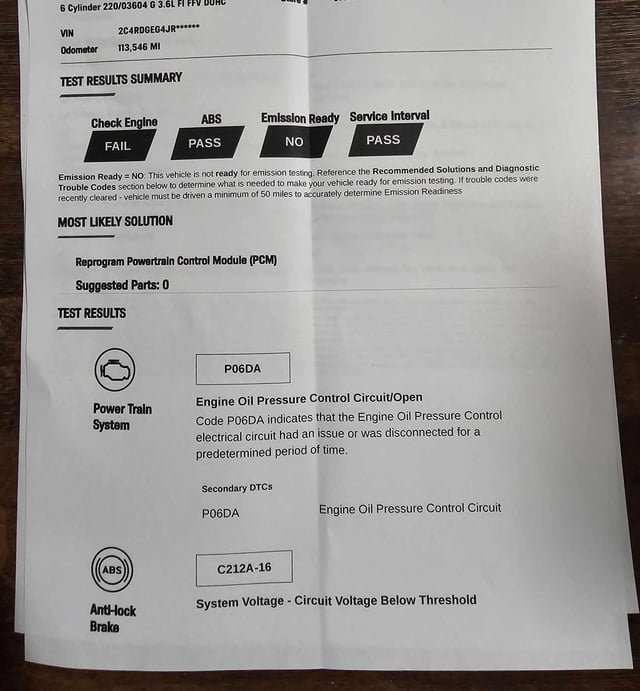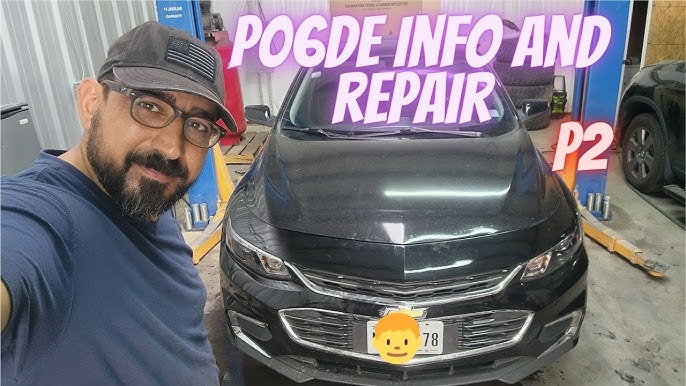To troubleshoot a P06DD error code, first check oil pressure and sensor functionality. Ensure engine oil is clean and within recommended levels.
Troubleshooting the P06DD error code, commonly associated with engine oil pressure control circuit issues, can be daunting for vehicle owners. This error code often indicates a specific concern related to the oil pressure not performing within expected parameters during engine operation.
The issue might stem from various sources, such as a failing oil pump, a defective oil pressure sensor, or inadequate oil levels. Proper lubrication is crucial for engine health, and addressing this code early can prevent further mechanical complications. Maintaining your vehicle’s engine in top condition requires immediate attention to such warning signs to ensure longevity and efficient performance. It’s vital to consult a qualified professional if you’re not experienced with car diagnostics and repairs.
Introduction To P06dd Error Code
The P06Dd error code is a common issue for drivers. This code signals a problem with the vehicle’s engine oil pressure. Modern cars have computer systems that monitor engine performance. When they detect an oil pressure problem, they trigger the P06Dd code. This is a warning to look closer at the engine’s oil operation.
Symptoms Of P06dd In Vehicles
- Check Engine Light: This light on the dashboard comes on.
- Engine Noise: Strange sounds might be heard from the engine.
- Performance Issues: The vehicle might run poorly or stall.
- Starting Trouble: It could be hard to start the car.
Potential Risks and Implications
| Risk | Implication |
|---|---|
| Engine Damage | The engine might get damaged without proper oil pressure. |
| High Repair Costs | Fixing engine damage can be costly. |
| Safety Hazards | Decreased performance can lead to safety issues on the road. |
| Decreased Vehicle Value | Long-term issues can lower the car’s resale value. |
Common Causes Behind P06dd Code
The P06Dd code is a diagnostic trouble code (DTC) that signals a problem with the engine. This issue can affect your car’s performance. Knowing common causes helps fix the code quickly. Let’s explore the leading factors that trigger P06Dd in engines.
Oil Pressure Issues
Oil pressure problems are a major cause of the P06Dd code. These can include:
- Low oil level due to leaks or consumption
- Using the wrong type of engine oil
- Blocked oil passages affect flow.
- A faulty oil pump is not circulating correctly.
Regularly check oil levels and quality to prevent these issues.
Faulty Engine Sensors
Engine sensors play a critical role in managing your vehicle’s health. Faulty sensors can cause the P06Dd. Common sensor issues include:
| Sensor Type | Problems |
|---|---|
| Oil Pressure Sensor | Incorrect readings lead to incorrect engine adjustments. |
| Camshaft Position Sensor | Disrupting engine timing and performance. |
| Crankshaft Position Sensor | Inaccurate readings affecting engine’s power. |
Replacing faulty sensors can clear the P06Dd code and restore engine function.
Initial Diagnostic Steps
When your vehicle’s check engine light flashes with code P06DD, it’s time to investigate. Early diagnosis stops small issues from becoming big ones. Begin with these steps.
Reading The Diagnostic Trouble Codes
Using an OBD-II scanner is the first step. Connect the scanner to your car’s port. Find the exact codes stored in the system. Write down these codes. They tell you what part of the engine to examine.
Checking For Additional Symptoms
Don’t rely on codes alone. Next, watch for signs like engine noise or oil leaks. Check your dashboard for warning lights. Make a list of these symptoms. This list helps you or your mechanic understand the issue better.
- Listen for unusual noises when starting the engine.
- Observe if the engine takes longer than usual to start.
- Watch out for any oil spots under the parked car.
- Monitor the oil pressure warning light on your dashboard.

Credit: www.youtube.com
Inspecting Oil Pressure
When your vehicle displays a P06DD code, it often points to oil pressure issues. A proper inspection helps keep engine wear and tear at bay. Follow these steps to ensure your vehicle can maintain optimal oil pressure. Let’s dive into the diagnosis with a focus on oil quality, level, and the oil pressure sensor.
Verifying Oil Quality and Level
Keeping an eye on oil integrity is critical. Dirty or low-quality oil may cause low pressure. It also affects engine performance negatively. Begin by examining the oil’s appearance and level.
- Switch off the engine and wait for it to cool.
- Locate the oil dipstick and pull it out.
- Wipe it clean and insert it back into the tube.
- Remove once more to check the oil level and quality.
Oil should appear clean and fall within the marked indicators on the dipstick. If not, it may be time for an oil change.
Testing Oil Pressure Sensor and Circuit
The oil pressure sensor plays a key role in monitoring the oil pressure. A faulty sensor or damaged circuit could trigger a P06DD code. Follow these steps to test the sensor and circuit functionality:
- Locate the oil pressure sensor on the engine block.
- Disconnect the sensor’s electrical connector.
- Use a multimeter to test for voltage and ground at the connector.
- Reconnect the sensor if the voltage and ground readings are correct.
If the sensor gives incorrect readings, consider replacing it. A professional mechanic will ensure proper installation.
Evaluating Engine Sensors
When dealing with a P06Dd trouble code, proper evaluation of engine sensors becomes critical. Sensors govern your engine’s health. They act like the nerves in a body, sending information to the brain—your car’s onboard computer. A hiccup in these sensors can lead to engine performance issues. Let’s diagnose these sensors step by step.
Checking Variable Valve Timing (VVT) Sensors
The VVT sensors play a pivotal role in your engine’s efficiency. To check them:
- Locate your VVT sensors—they’re usually near the camshafts.
- Use a scanner tool to look for anomalies in the VVT data readings.
- Inspect the sensors for any visible damage or oil contamination.
- Test sensor resistance with a multimeter and compare it to manufacturer specs.
If VVT sensor signals are erratic or nonexistent, replacement may be necessary.
Examining Camshaft/crankshaft Correlation
Correct timing between the camshaft and crankshaft is essential for smooth operation. To examine:
- Check for error codes that suggest a correlation issue.
- Physically inspect the timing chain or belt for wear.
- Analyze the data from both sensors using a diagnostic scanner.
Discrepancies between these sensor readings often flag a problem with timing components.
Regular maintenance and prompt attention to engine warnings can prevent costly repairs. By staying on top of sensor health, engines run smoother, and your vehicle stays reliable. Embrace the DIY spirit or seek a professional’s help when in doubt.

Credit: www.reddit.com
Examining Variable Valve Timing Components
When your engine light turns on with a P06Dd code, it signals an issue with the Variable Valve Timing (VVT) system. A smooth-running engine relies on precise timing. The VVT system plays a crucial role in performance and efficiency. Unpacking the intricacies of VVT can seem daunting. Yet, a methodical approach helps locate the problem swiftly. Start by examining the VVT components attentively.
Inspecting VVT Solenoids
The heart of the VVT system beats with the VVT solenoids. These tiny yet mighty parts command the oil flow to the camshaft adjusters. A faulty solenoid can wreak havoc on engine timing. Use these steps for a thorough inspection:
- Locate the VVT solenoids on the engine.
- Check for oil leaks or damage.
- Measure the solenoid’s resistance with a multimeter. Compare it to the standard range specified by the manufacturer.
- Visually inspect the connectors and wiring for any signs of wear or corrosion.
Checking the Timing Chain and Related Parts
With the VVT solenoids checked, shift focus to the timing chain and its associated parts. They must be in top shape for impeccable engine timing. The timing chain synchronizes the crankshaft and camshaft rotations. Here’s how to check them:
- Inspect the timing chain for slackness or wear.
- Look at the tensioners and guides. They should be intact, not worn or broken.
- Examine the sprockets for any signs of damage or abnormal wear.
Replace any component that does not meet the specifications. This will ensure optimal engine performance and prevent future P06Dd codes.
Advanced Diagnostic Procedures
When your vehicle displays a P06Dd error code, it signals a complex issue under the hood. Advanced diagnostics can uncover problems that basic code readers miss. Professional mechanics use detailed testing to find the root cause. They focus on engine health and sensor accuracy. Here are two critical tests for in-depth troubleshooting.
Performing A Leak Down and Compression Test
Engine compression is like a heart’s pulse for your car. A leak down and compression test will check if the engine’s heart is beating strongly. The test identifies where problems are hiding. It guides mechanics to issues with valves, piston rings, or gaskets. Correcting these can clear your P06Dd error.
Steps for a Compression Test:
- Warm up the engine to operating temperature.
- Remove the spark plugs.
- Insert a compression gauge into the spark plug hole.
- Have someone crank the engine while you read the gauge.
- Repeat for each cylinder and compare the results.
Steps for a Leak Down Test:
- Insert the leak down tester into the spark plug hole.
- Set to the correct cylinder pressure.
- Listen for air leaks and pinpoint their origin.
Analyzing Live Data with a Scan Tool
A scan tool offers a window into your engine’s operation in real time. It reads data streams from different sensors. This helps find issues missed by static code readings. The data can reveal if the problem stems from oil pressure, temperature sensors, or other components.
Data Points to Monitor:
- Engine RPM
- Oil Pressure
- Fuel Trim Values
- Oxygen Sensor Readings
- Coolant Temperature
Look for any out-of-norm readings. They can point to specific issues. A professional will interpret these readings. They will fix problems causing the P06Dd code.
Fixes And Solutions
An error code P06DD signals an issue with your vehicle’s engine oil pressure. When the engine’s computer detects a problem with the oil pressure control, it throws this code. This could stall your ride-or-drop performance. Let’s explore efficient fixes and solutions to address this error. With quick action, your car might regain its optimal condition.
Replacing Faulty Sensors
Oil pressure sensors play a crucial role in keeping your engine safe.
Once a diagnostic test pinpoints a faulty sensor, a replacement becomes necessary. Here’s a step-by-step guide:
- Find the faulty sensor based on the diagnostic report.
- Unplug the sensor’s electrical connector.
- Remove the old sensor with a sensor socket.
- Install the new sensor and tighten it carefully.
- Reconnect the electrical connector.
- Clear the P06DD code and test the vehicle.
Replace sensors at trusted service centers to ensure proper fitting and functionality.
Servicing The VVT System
The Variable Valve Timing (VVT) system improves performance and efficiency.
Regular servicing can prevent P06DD codes from popping up. The service may include:
- Checking the VVT solenoids and actuators.
- Replacing clogged or malfunctioning parts.
- Cleaning oil passages to ensure smooth operation.
- Changing the engine oil to the correct specifications.
A well-maintained VVT system equals a happy, healthy engine.
Prevention And Maintenance Tips
Keeping your vehicle free from the dreaded P06DD error code begins with consistent care. Prevention and maintenance are key to avoiding this engine issue. Simple, routine checks and services can save time, money, and the hassle of dealing with engine performance problems. Let’s explore some essential habits that can keep your car running smoothly.
Regular Oil Changes and Maintenance
Maintaining your vehicle’s lifeblood through regular oil changes is crucial. Clean oil ensures proper engine lubrication, which reduces wear and prevents overheating.
- Follow your car’s maintenance schedule.
- Use the recommended oil type.
- Check oil levels monthly.
- Change oil filters with each oil change.
Document each service to keep track of your vehicle’s maintenance history.
Monitoring Engine Performance Regularly
Keep a keen eye on how your engine behaves. Warning signs often precede the P06DD code, indicating that it’s time for a check-up.
- Listen for unusual noises.
- Watch for changes in engine responsiveness.
- Pay attention to fuel efficiency.
- Look for warning lights on the dashboard.
Using a diagnostic tool can offer early detection and peace of mind.
| Maintenance Action | Frequency | Benefit |
|---|---|---|
| Oil Change | 3,000-5,000 miles | Engine protection |
| Filter Replacement | Each oil change | Clean system |
| Performance Check | Bi-annual | Early problem detection |
Proactive maintenance not only prevents P06DD but also extends your vehicle’s longevity.

Credit: www.autonationmobileservice.com
Seeking Professional Help
Encountering a P06DD error code in your vehicle can be baffling. Seeking professional help ensures your car gets the right fix. Car problems need a trained eye for proper resolution. It’s about your safety on the road.
When To Contact a Mechanic
Recognizing the right time to call a mechanic prevents bigger issues. Here’s when you should reach out:
- Warning lights on the dashboard are not to be ignored.
- Your car makes strange noises or has unusual performance issues.
- When DIY fixes and reset attempts fail, professionals take over.
- Regular maintenance checkups avoid emergencies.
Understanding The Importance of Expert Diagnosis
Getting an expert diagnosis is like consulting a doctor for your health. Experts have the tools and training to find the real issue. They ensure accurate repairs and help you avoid unnecessary costs. Mechanics save you time and guarantee safety.
| Benefit | Explanation |
|---|---|
| Accuracy | They pinpoint the exact fault. |
| Tools | They have specialized equipment for diagnosis. |
| Experience | They’ve seen similar issues and know solutions. |
| Warranty | Repairs often come with service guarantees. |
Troubleshooting P06DD requires understanding complex engine systems. Let your mechanic handle the stress. Drive your car with confidence, knowing it got the best care.
Frequently Asked Questions on Troubleshooting P06dd
What Could Cause P06dd Code?
The P06DD code can result from a faulty oil pump, blockages in the oil system, or a malfunctioning oil pressure sensor.
Can I Drive with Code P06dd?
Driving with code P06DD is not recommended as it indicates an engine oil pressure control circuit/stuck off issue, which could lead to engine damage. Seek immediate mechanical attention to avoid potential safety risks and further vehicle damage.
How Do You Reset an Oil Pressure Sensor?
To reset an oil pressure sensor, first turn off your vehicle’s engine. Then, disconnect the car battery for a few minutes. Reconnect the battery and start the engine to check if the sensor has reset.
How Do I Know If My Oil Pump or Oil Pressure Sensor Is Bad?
To determine if your oil pump or sensor is failing, check for low oil pressure warnings, engine noise, or overheating. Observe the oil pressure gauge for irregularities as well. If symptoms persist, have a mechanic conduct a professional diagnosis.
Conclusion
Navigating the P06Dd error can be daunting, but armed with the right knowledge, it’s manageable. Remember to diagnose systematically, considering common culprits like oil viscosity and sensor issues. Regular maintenance often prevents such errors. Seek professional help when in doubt, ensuring your vehicle remains in peak condition.
Stay road-ready with these troubleshooting tips.


